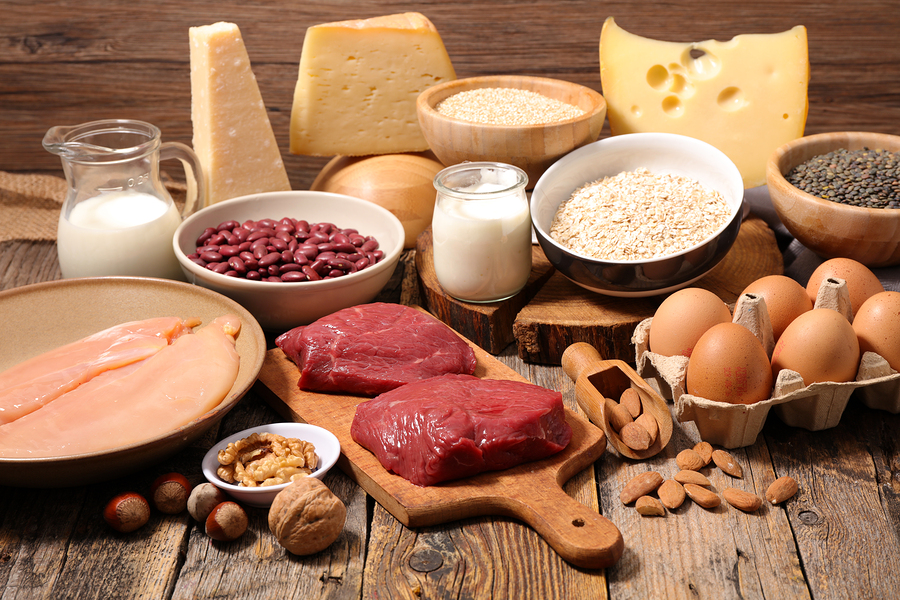
**** Dietitian support during COVID-19****
Protein is an essential nutrient to keep your body functioning well. Proteins are part of every cell in your body and are needed to build and repair muscle, tissue, skin, nails and hair. Protein also helps build hormones and enzymes. Here are some tips for healthy protein choices.
What foods contain protein?
Mostly protein: Meat, poultry, fish, eggs, tofu
Some protein: Legumes, nuts, nut butters, seeds, seed butters, milk, cheese, cottage cheese, soy beverages, yogurt
Little protein: Whole grain breads, rice, pasta, quinoa, barley
How much protein do you need?
Adults (19 years and over) need 0.8 grams of protein for every kilogram of body weight. For example, if you weigh 68 kg (150 lbs), then you would need about 55 g of protein per day.
Check out some of the sample meal ideas below to figure out how much protein you may be getting from some common foods.
As long as you’re getting enough calories and eating a variety of protein containing foods, healthy adults, athletes and vegetarians don't usually need extra protein. Talk to a dietitian about the amount of protein that children, pregnant women and breastfeeding women need.
Making healthy protein food choices
Choose protein foods that come from plants more often. Plant-based protein foods can provide more fibre and less saturated fat than other types of protein foods. This can be beneficial for your heart health.
Legumes such as beans, lentils, and soy foods like tofu are good sources of protein:
Did you grow up in a family where meat took centre stage on the dinner plate? Try having meat-free meals more often. Many of these plant sources of protein are high in fibre and low in saturated fat, so they help you stay full and keep your heart healthy.
Try nuts and seeds:
Nuts, seeds and their butters are good sources of protein and healthy monounsaturated fats. They make great afternoon snacks and yummy additions to salad, cereal and yogurt.
Eat fish more often:
Fish are a good source of protein but even more important – they are an excellent source of omega-3 fats. Regular consumption of fish with omega-3 fats can help to reduce the risk of heart disease. Good choices include char, herring, mackerel, rainbow trout, salmon and sardines. If you are choosing fish instead of other high fat foods, this will be good for your weight and your heart. Just remember to prepare your fish in a heart healthy way such as baking, broiling, grilling or poaching.
For information on fish and mercury risk: Get the reel scoop on fish and mercury
Choose lean meats and skinless poultry:
-
When choosing beef, look for well-trimmed eye of round or sirloin, or extra lean ground beef.
-
Lean ham, pork tenderloin or loin chops are good pork choices.
-
Remove the skin from chicken or turkey, as the skin is high in saturated fat. White meat has less fat than dark meat.
-
Avoid drowning your meat or poultry in high fat sauces such as cream, gravy and butter. Try marinades made with lemon, garlic, yogurt and herbs and spices to get maximum flavour.
-
Cooking methods to try that require less fat: Baking, broiling, grilling, roasting and barbequing.
How much proteins do vegetarians need?
People often think that being a vegetarian or vegan means that it can be hard to get enough protein. Not true! There are many vegetarian sources of protein. Eggs, low-fat cheese, yogurt and milk are good animal protein sources. Vegans can enjoy beans, lentils, dried peas, tofu, nuts and seeds. Vegetables and grain products all contain small amounts of protein too.
Vegetarian diets have been linked to lower risk for obesity, heart disease and some types of cancer. Even if you’re not a vegetarian try having a meal centred on plant sources of protein at least once a week.
Need some ideas for getting more vegetable protein in your diet?
-
Start your day with a whole-grain cereal or a bowl of oatmeal. Increase the flavour with some almonds or pumpkin seeds. (1/4 cup oatmeal = 3 g protein; 1/4 cup almonds = 8 g protein )
-
Busy morning? Make your own protein bars the night before for a portable breakfast. (1 bar = 7 g protein)
-
Add chickpeas, lentils or black beans to your soup or salad at lunch. (3/4 cup black beans = 11 g protein; ¾ cup lentils = 13 g protein)
-
Make a hearty bowl of lentil soup for dinner.
-
Cook up a big bowl of bean rich chili that’s loaded with vegetables. (1 serving = 14 g protein)
-
Choose whole grain breads and crackers with sliced cheese (1 slice bread = 3 g protein; 50 g cheese = 12 g protein)
-
Great pre or post exercise snacks are mini-yogurt or cottage cheese cups. (3/4 cup yogurt = 8 g protein)
-
Need an afternoon pick-me-up? Try peanut butter on whole grain bread with a glass of milk or soy beverage. (2 tbsp peanut butter = 7 g protein)
-
Try this tofu stir-fry loaded with vegetables and flavoured with sweet chilli sauce. (3/4 cup tofu = 16 g protein)
-
Try a quinoa salad instead of pasta. Quinoa is a whole grain that is also a source of protein. (1/2 cup quinoa = 3 g protein)
For more information on protein:
The Scoop on Soy
All About Legumes
Sports nutrition: Facts on carbohydrate, fat and protein
Last Update – June 10, 2020